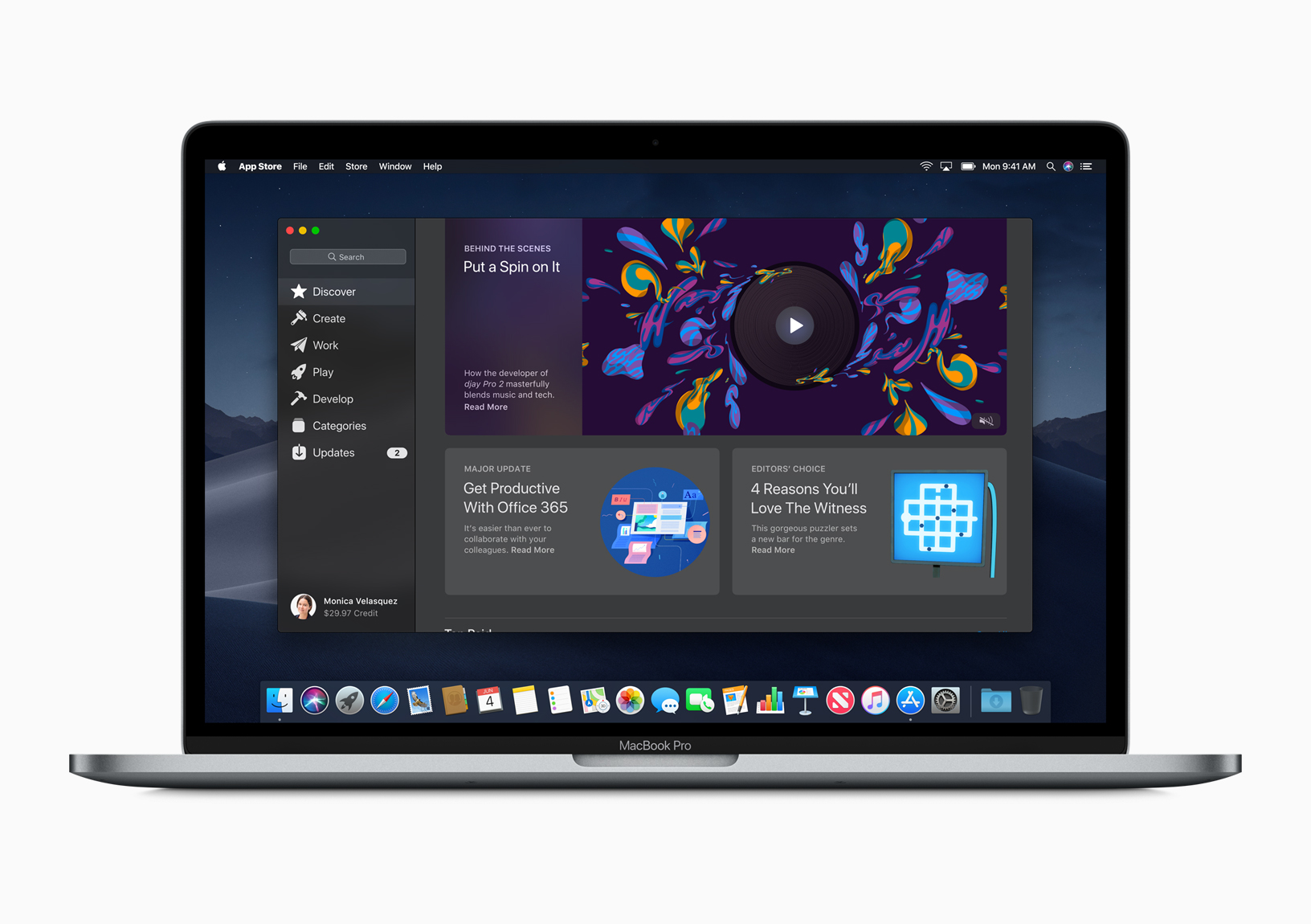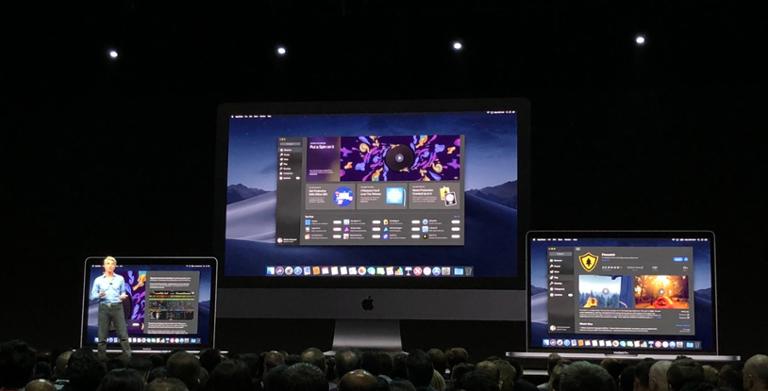Inside macOS Mojave, the upcoming update to Apple's desktop and laptop operating system, lives
a fresh take on the Mac App Store, that nearly-forgotten portal for desktop apps. Apple wants developers and users to enjoy their experience, which prompted the redesign, but there’s a lot more under the hood. The design will be familiar to those in the Apple ecosystem. It’s akin to the iOS App Store, with proper app landing pages and video previews for apps. Developers can also use an in-app API to elicit reviews and ratings, just like on iOS. The Mac App Store differentiates itself by including a sidebar for topics better suited to the desktop. Whereas the iOS App Store has ‘apps’ and ‘games,’ the Mac App Store will have four distinct categories: 'create,' 'work,' 'play,' and 'develop.' This speaks to Apple’s insistence that the new-look Mac App Store is also powerful, and a proper method for professionals to discover new apps, tools, and services. To make its point, Apple will launch the new Mac App Store with four unique partners. Microsoft will bring the Office 365 suite, Adobe’s Lightroom CC is on the way, and BBEdit from Bare Bones Software is also arriving this Fall. Panic’s Transmit will make a return to the Mac App Store. This is where things get interesting. Office 365 is apparently being
totally re-written in JavaScript (not traditional Apple frameworks or SDKs). BBEdit and Transmit were both removed from the Mac App Store long ago by their respective development teams over issues related to upgrade pricing and free trials (among a few other issues). When iOS 12 and macOS Mojave land this Fall, developers will be able to offer free trials for apps, so long as this is clearly communicated to the customer. There’s also tooling to offer tiered pricing for subscriptions (where the first year may cost $1, and subsequent annual pricing might be $5, for example).

On macOS, more pricing flexibility is critical. Both BBEdit and Transmit were doing fine away from the Mac App Store, and
many other apps do well without ever appearing on the Mac App Store. In
a blog post, iA noted that its Writer app was being punished by the Mac App Store for being popular, which seems like an algorithmic oddity meant to repudiate the Mac App Store
from all the ‘zombie’ apps it’s trying to ditch.
In a survey from MacPaw, macOS developers by and large saw the Mac App Store as something to avoid. Even those selling via the Mac App Store without hedging bets outside of it said they “wouldn’t recommend it unless they kind of hate” the person they were referring to it. Sandboxing has been a huge hurdle. Apple has long asked that apps distributed in the Mac App Store simply play in their own realm; apps downloaded from the web had to be signed by an Apple developer, lest users get scary pop-ups telling them Apple had no idea who the downloaded app was from. Jason Snell at Six Colors says this practice is easing. From
his post:
Apps are able to ask for permission to creep out of the restrictive “sandbox” and access files more broadly across your Mac’s hard drive. The severe restrictions of the Mac App Store’s security policies were one of the reasons most frequently cited by developers who decided to bail out on the store and just go back to selling apps directly.
For those apps living outside the Mac App Store, Snell writes they can now be “notarized” by being uploaded to an Apple server, which scans them for known malware. This isn’t a review; it’s a half-step for security, and possibly a way for Apple to reach out to more developers and encourage them to make their apps available via the Mac App Store. Taken in context, what we’re seeing is Apple extending the leash for Mac App Store apps while trying to corral those outside the Mac App Store, broadening its reach and scope. The approach seems to be more apps Apple has qualified as ‘good’ rather than just grabbing for anything that will pass review. The moves won’t please everyone, but they rarely do. We should keep in mind that
Apple’s extended macOS universe will soon open a portal to the iOS sphere, and developers will have the ability to make their apps available to both platforms. The rules have to make sense for both ecosystems.
 On macOS, more pricing flexibility is critical. Both BBEdit and Transmit were doing fine away from the Mac App Store, and many other apps do well without ever appearing on the Mac App Store. In a blog post, iA noted that its Writer app was being punished by the Mac App Store for being popular, which seems like an algorithmic oddity meant to repudiate the Mac App Store from all the ‘zombie’ apps it’s trying to ditch. In a survey from MacPaw, macOS developers by and large saw the Mac App Store as something to avoid. Even those selling via the Mac App Store without hedging bets outside of it said they “wouldn’t recommend it unless they kind of hate” the person they were referring to it. Sandboxing has been a huge hurdle. Apple has long asked that apps distributed in the Mac App Store simply play in their own realm; apps downloaded from the web had to be signed by an Apple developer, lest users get scary pop-ups telling them Apple had no idea who the downloaded app was from. Jason Snell at Six Colors says this practice is easing. From his post:
On macOS, more pricing flexibility is critical. Both BBEdit and Transmit were doing fine away from the Mac App Store, and many other apps do well without ever appearing on the Mac App Store. In a blog post, iA noted that its Writer app was being punished by the Mac App Store for being popular, which seems like an algorithmic oddity meant to repudiate the Mac App Store from all the ‘zombie’ apps it’s trying to ditch. In a survey from MacPaw, macOS developers by and large saw the Mac App Store as something to avoid. Even those selling via the Mac App Store without hedging bets outside of it said they “wouldn’t recommend it unless they kind of hate” the person they were referring to it. Sandboxing has been a huge hurdle. Apple has long asked that apps distributed in the Mac App Store simply play in their own realm; apps downloaded from the web had to be signed by an Apple developer, lest users get scary pop-ups telling them Apple had no idea who the downloaded app was from. Jason Snell at Six Colors says this practice is easing. From his post:


